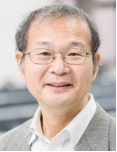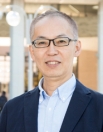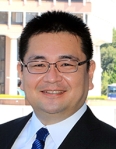报告时间:4月29日(星期一)上午9:30
报告地点:信息楼310
(一)
报 告 人:高木茂行教授,日本东京工科大学
(Shigeyuki Takagi, Tokyo University of Technology, Japan)
报告题目:Optimization of outer rotor type PMSM using coupled calculation of electromagnetic field simulation and genetic algorithm
内容简介:Outer rotor type permanent magnet synchronous motors (SMPMs) can generate large output torque. Taking advantage of the characteristics, it is expected to be applied to assist motors for automobile brakes. To increase the torque, we evaluated the relationship between output torque and the magnetic field arrangement rotor using the electromagnetic field simulator JMAG.
We measured the motor characteristics of a commercially available outer rotor type PMSM and constructed a simulation model that can reproduce these characteristics. On the basis of this simulation model, we evaluated multiple magnetic field arrays including the Halbach array. Furthermore, we optimized the Halbach structure with soft magnetic material, which was confirmed to be effective in improving torque, using a combination of JMAG and genetic algorithms. The results showed that the output torque could be increased from 3.01 Nm to 5.05 Nm with an outer rotor type PMSM of the same size.
作者简历:Prof. Shigeyuki Takagi received the B.S.E.E. and M.S.E.E. from Nagoya University. He joined Toshiba Corporation in 1984 and developed a high-voltage, high-current semiconductor switch power supply for gas lasers. He became a professor in the Department of Electrical and Electronic Engineering, Tokyo University of Technology in 2015. His research interests include power electronics, batteries, digital controls, simulation, and electric vehicles. Prof. Takagi is a member of the Institute of Electrical Engineers of Japan (IEE of Japan) and the Japan Society of Applied Physics.
(二)
报 告 人:新海健教授,日本东京工科大学
(Takeshi Shinkai, Tokyo University of Technology, Japan)
报告题目:Current-limiting HVDC circuit breaker with multiphase thermal plasma to achieve multi-terminal HVDC transmission system
内容简介:Research activities at High Power Systems Laboratory in Tokyo university of technology will be introduced. As the main topic, high voltage direct current (HVDC) circuit breaker for application to multi-terminal HVDC transmission system (MTDC) will be presented; the role of HVDC-CB in MTDC and the concept and the research status of a new current-limiting HVDC.
作者简历:Prof. Takeshi Shinkai received his B. Sc. and M.S. degree in electrical engineering from Waseda University, Japan, and Ph. D. degree in electrical engineering from University of Tokyo, Japan. He joined Toshiba Corporation in 1993 and became a professor in the Department of Electrical and Electronic Engineering, Tokyo University of Technology in 2015. He has studied interruption phenomena and developed interrupting chamber. He is IEEE and IEEJ member.
(三)
报 告 人:荒川貴博教授,日本东京工科大学
(Takahiro Arakawa, Tokyo University of Technology, Japan)
报告题目:Wearable Biosensors and Bio-imaging System of Volatile Organic Compounds for Healthcare Monitoring
内容简介:The measurement of biophysical quantities of the human body has garnered significant attention in the medical and healthcare fields. Wearable sensors have emerged as promising tools for monitoring relevant parameters in healthcare, sports, and medical applications. Leveraging biophysical information with these systems is expected to enable proactive health management, thereby improving public health and reducing medical expenditure. This paper discusses two types of wearable biosensors: tear and saliva glucose biosensors. Our group has developed soft contact lens biosensors for tear chemicals and oral cavity biosensors, such as mouthguard biosensors for salivary analysis. Challenges related to integrating biosensors into monitoring biological information and daily medicine are also addressed. Moreover, recent advancements in analytical devices have facilitated the measurement of minute amounts of odorous materials and volatile chemical compounds. Human breath and skin volatiles, including gases from halitosis and body odor, contain compounds indicative of metabolic processes and specific ailments. Measurement of these volatile biological compounds holds promise for simplifying metabolic capacity evaluation, medical diagnostics, and disease screening. We have developed a novel two-dimensional fluorometric imaging system for detecting ethanol vapor released from human breath and palm skin. This imaging system measures ethanol vapor concentrations by analyzing the fluorescence intensity of nicotinamide adenine dinucleotide (NADH) through an enzymatic reaction induced by alcohol dehydrogenase. The NADH fluorometric imaging system enables real-time, two-dimensional imaging of ethanol vapor distribution at ppb concentration levels. We applied this imaging system to measure breath ethanol vapor and skin ethanol vapor from a human palm, demonstrating rapid and accurate responses with visible measurements. This technology holds promise for real-time analysis of metabolism function in the near future.
作者简历:Dr. Takahiro Arakawa is currently an Associate Professor of Department of Electric and Electronic Engineering, Tokyo University of Technology since 2021. He received his BS, MS degrees from Waseda University in 2002 and 2004, respectively. He finished the Ph.D. course in Nano-science and Nano-engineering, and received the Ph.D. degree in “Microfluidic system for cell analysis” Waseda University in 2007. In 2008, he joined a post-doctoral research fellow of Japan Society for the Promotion of Science (JSPS, PD) at the Laboratory of Bioanalytical Chemistry the University of Tokyo. Since 2009, he was an Assistant professor of Tokyo Medical and Dental University (Department of Biomedical Devices and Instrumentation). He has been a Junior Associate Professor since 2014. He joined Departments of Electrical Engineering and Bioengineering at University California Los Angeles as a visiting researcher from 2017 to 2018. His research interests include microfluidics, bio micro electro mechanical system (Bio-MEMS), biosensors, optical system and bio microsystems for medical applications.

